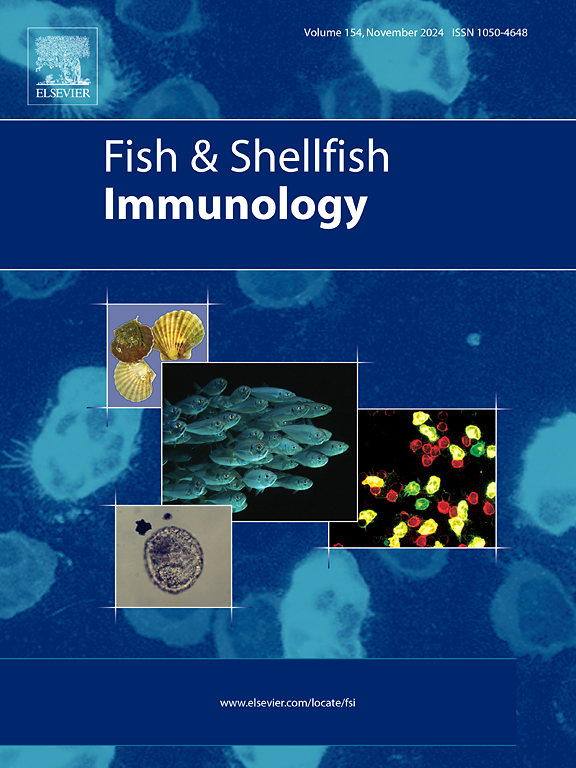草鱼再病毒(GCRV)感染会激活 PERK-eIF2α 通路,从而促进病毒复制。
IF 3.9
2区 农林科学
Q1 FISHERIES
引用次数: 0
摘要
草鱼再病毒(GCRV)属于水生病毒属,可导致草鱼(Ctenopharyngodon idella)严重出血性疾病,死亡率极高。许多动物病毒已被证明可激活内质网应激(ERS)。然而,GCRV 感染诱导 ERS 的可能性及其对病毒感染的影响仍不清楚。在这项研究中,我们证明了 GCRV 感染会诱导 ERS,激活蛋白激酶 R 样 ER 激酶(PERK)通路,并抑制未折叠蛋白反应(UPR)中的肌醇需要酶 1(IRE1)和激活转录因子 6(ATF6)通路。此外,我们还通过药物治疗和小干扰 RNA(siRNA)调节了 CIK 细胞中 ERS 和 UPR 通路的水平。我们的研究结果表明,ERS的发生加速了GCRV感染,而UPR中的ATF6和IRE1通路则对GCRV感染起负向调节作用。相反,PERK通路促进了GCRV感染。此外,我们还发现 GCRV 感染会诱导氧化应激,活性氧(ROS)的产生受 PERK 通路和下游基因内质网氧化还原酶-1α(ERO1α)的正向调节。值得注意的是,ROS 促进了 GCRV 感染。总之,我们的研究结果表明,GCRV 感染会激活 ERS,而 ERS 又会通过 PERK-ERO1α-ROS 信号通路促进病毒感染。因此,PERK通路可作为预防GCRV感染的新型抗病毒靶点。本文章由计算机程序翻译,如有差异,请以英文原文为准。
Grass Carp Reovirus (GCRV) infection activates the PERK-eIF2α pathway to promote the viral replication
Grass carp reovirus (GCRV) belongs to the genus Aquareovirus and is responsible for causing serious hemorrhagic disease in grass carp (Ctenopharyngodon idella), characterized by high mortality rates. Numerous animal viruses have been shown to activate endoplasmic reticulum stress (ERS). However, the potential for GCRV infection to induce ERS and its implications for viral infection remain unclear. In this study, we demonstrated that GCRV infection induces ERS, activates the protein kinase R-like ER kinase (PERK) pathway, and inhibits both the inositol-requiring enzyme 1 (IRE1) and activating transcription factor 6 (ATF6) pathways within the unfolded protein response (UPR). Additionally, we modulated the levels of ERS and UPR pathways in CIK cells through drug treatment and small interfering RNAs (siRNAs). Our findings revealed that the onset of ERS accelerated GCRV infection, while the ATF6 and IRE1 pathways within the UPR negatively regulated GCRV infection. Conversely, the PERK pathway facilitated GCRV infection. Furthermore, we showed that GCRV infection induced oxidative stress, with the production of reactive oxygen species (ROS) being positively regulated by the PERK pathway and the downstream gene endoplasmic reticulum oxidoreductase-1α (ERO1α). Notably, ROS promoted GCRV infection. Collectively, our findings indicate that GCRV infection activates ERS, which in turn promotes viral infection through the PERK-ERO1α-ROS signaling pathway. Thus, the PERK pathway may serve as a novel antiviral target for the prevention of GCRV infection.
求助全文
通过发布文献求助,成功后即可免费获取论文全文。
去求助
来源期刊

Fish & shellfish immunology
农林科学-海洋与淡水生物学
CiteScore
7.50
自引率
19.10%
发文量
750
审稿时长
68 days
期刊介绍:
Fish and Shellfish Immunology rapidly publishes high-quality, peer-refereed contributions in the expanding fields of fish and shellfish immunology. It presents studies on the basic mechanisms of both the specific and non-specific defense systems, the cells, tissues, and humoral factors involved, their dependence on environmental and intrinsic factors, response to pathogens, response to vaccination, and applied studies on the development of specific vaccines for use in the aquaculture industry.
 求助内容:
求助内容: 应助结果提醒方式:
应助结果提醒方式:


